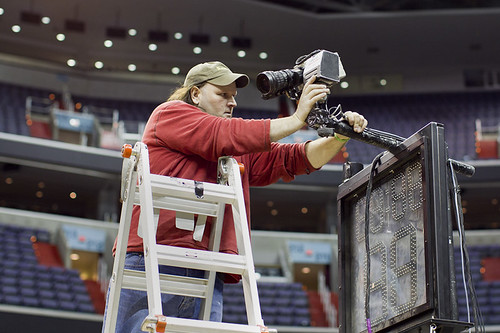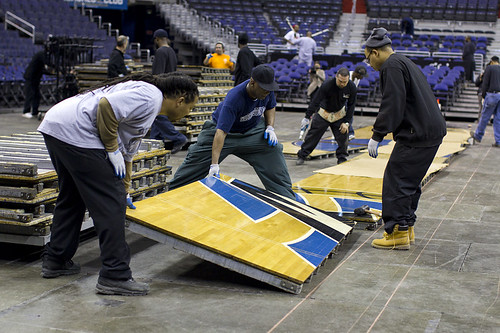
‘Verizon Center change over’
courtesy of Max Cook
Last Saturday was a busy day for the bull gang at Verizon Center.
Then again, the operations crew working in the hub of Chinatown is always busy.
Yet, last Saturday was a little bit different. Verizon Center makes multiple switches every week from a hockey arena for the Capitals to basketball for the Wizards with modifications for both Georgetown and the Mystics. Normally, it goes from basketball to hockey, a familiar process for the crew. On Saturday it was a quick afternoon turnaround though from hockey to basketball as the Caps played an uncharacteristic early-afternoon matinee at 12:30 p.m. and the Wizards had a later-than-usual start at 8:00 p.m.
Both teams lost. Badly.
It turned out to be a marathon day for this reporter. It came to the point where our fearless leader, Tom, was set to dispatch a St. Bernard to the Verizon Center with one of those little casks tied around its neck as part of a rescue team. Being a working Saturday, I naturally told Tom to have the St. Bernard’s cask (in my mind I called him TimBo) filled with tequila. A working man has a powerful thirst, you know.
In between games I had full run of the stadium. In my career as a sports reporter that is not unusual. I always took the approach as a reporter that it is better to ask for forgiveness than permission so I tend to go and do as I please when I can. So, shortly after the Caps were dropped by the Kings and the postgame press interviews with the players and coach Bruce Boudreau was done, I went and found Sheila Francis, director for events and corporate communications for Monumental Entertainment, which runs the operations crew at Verizon Center. Also present was one of WeLoveDC’s uber-photographers, Max Cook, who had set up a camera in section 118 and was creating a time lapse of the change over as the bull gang dutifully went through its duties. The camera took a picture every 10 seconds for the approximately two-and-a-half hours it took to go from hockey rink to basketball floor, which, according to vice president of operations at Verizon Center Bill Harpole, is a little longer than normal for the crew. It is easier, Harpole said, to go from basketball to hockey because it is more of a tear-down operation than a build-up. Yet, the crew was finely tuned and blew through the process with efficiency.
Here is the time lapse:
Verizon Center – Hockey to Basketball from Max Cook on Vimeo.
For the record, the operations crew at Verizon Center, or any other multi-purpose stadium, is not actually called the bull gang. Harpole and Francis, who were going through a series of interviews with a group of Asian reporters from an outlet that I did not recognize and also with our community partner TBD.com, did not understand why everyone always refers to operations as a bull gang. I had never really thought of it, really. To me it was just an easy term to describe the operations staff. And it sounds cooler. For the record, Websters Online Dictionary defines a bull gang as such: ” A term applied to any member of a crew engaged in manually lifting or moving heavy objects or materials. Usually these workers exercise considerable physical exertion to accomplish a specified task. Classifications are made according to the nature of the work activity as construction worker.”
Really, I am not that far off, but Harpole and Francis insisted that the operations crew (which I believe is the preferred term), was not a bull gang. Semantics, more or less.
The crew is run by a man named Kim Webster who has been working the change overs in D.C. for 37 years. That dates back to the Capitals Centre before Verizon was built in 1996.

‘Laying Deck at Verizon Center’
courtesy of Max Cook
Note: Webster is not actually in that picture.
Webster looks kind of like an old hippy with white hair and a baseball cap, middle height and skinny. He was too busy to talk to but it looked like he handled his crew with authority and care, laughing around with the guys and directing them to the places they needed to go.
The process is actually quite easy when seen up close. After a hockey game ends the first thing the crew does is begin laying deck boards on top of the ice while a different part of the crew starts taking down the safety-glass panels on the boards. Each deck board panel, which are made from a pliable rubber, at Verizon Center are approximately three feet wide and seven or eight feet long. The boards are slid into place one at a time while little four-wheel tractors haul them around the rink. Harpole said that most stadiums used to use plywood but moved to the deck board within the last decade or so. I have seen this process many times in stadiums across the NBA/NHL. When I was in Boston I, at first, thought it was very cool to watch the bull gang/operations crew lay the panels while I was writing up postgame articles about the Bruins at TD Garden (it was TD Banknorth Garden when I started but so is the way of stadium naming, especially that particular stadium). What I found could be a bit of a shock to stadium operations aficionados around the country . . .
It is really annoying.
The panels in Boston are much bigger than the ones at Verizon. Perhaps 10 feet by 10 feet or so. They are wedged together by the crew and let fall to the ice with a giant “slap!” Imagine sitting in a press box trying to write and all you hear the entire time is “slap! slap! slap!” every minute or so. When I attained a seat in the TD Garden press room away from the operations crew, I was more than happy to leave the change over folks to their work. It is a decidedly quieter process at Verizon.
I asked Harpole what kind of condition all these panels, hammers, tractors and people left the ice. Verizon Center is not known for its quality hockey conditions. Harpole said that, of all the 30 stadiums in the NHL, Verizon is usually ranked about 14th in the league. After every NHL game the officials are asked to rate the quality of the ice surface and the aggregate of the report for the season is released to the operations crews of all the arenas. I was actually surprised, coming from my experience as a New England hockey fan growing up, that any team near or below the Mason-Dixon line could be ranked in the top half of the league, even if just barely (for the record, Edmonton is considered to have the absolute best ice in the NHL, year-in, year-out).
The crew finished putting the final touches on the Wizards court somewhere between 5:30 and 6 p.m. Just about in time for coach Flip Saunders pre-game interview with the press on the court during the Wizards shoot around.
In addition to basketball and hockey, there are a variety of other events at Verizon that require the attention of the operations crew. Disney On Ice comes about once a year in which case the gang will paint the ice white to hide the Capitals logo and the blue and red lines. When Disney leaves, the paint is scraped away and the surface retouched (which is a daily process more or less done with a hose). There are a variety of concerts at Verizon (wasn’t Lady Gaga here last fall?). It is a full time job for Harpole and his organization and one that often goes unappreciated by fans.
So, next time you are at Verizon, sitting in your seat drinking a beer and about to start cursing towards the direction of the action, give a silent nod to Webster and his crew. If you see them out and about D.C, buy them a beer. These are some hard working men. And working men have a powerful thirst.
Pingback: Tweets that mention From hockey to basketball at Verizon: A familiar routine » We Love DC -- Topsy.com